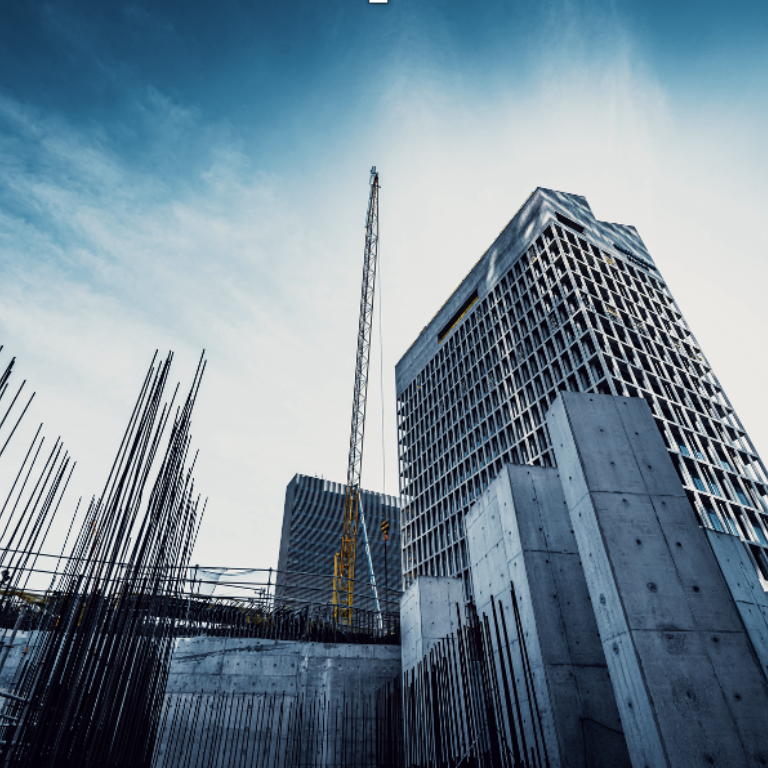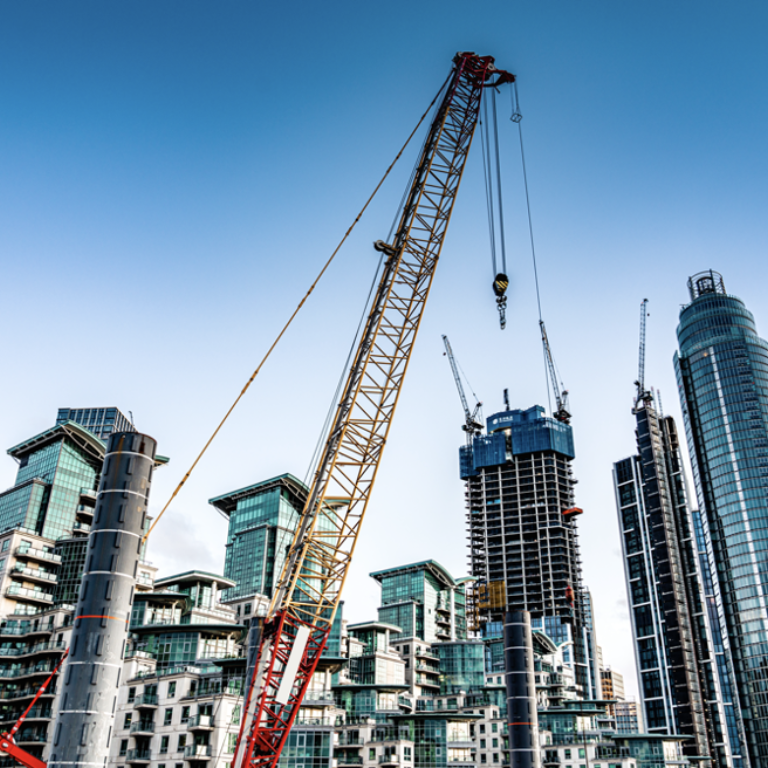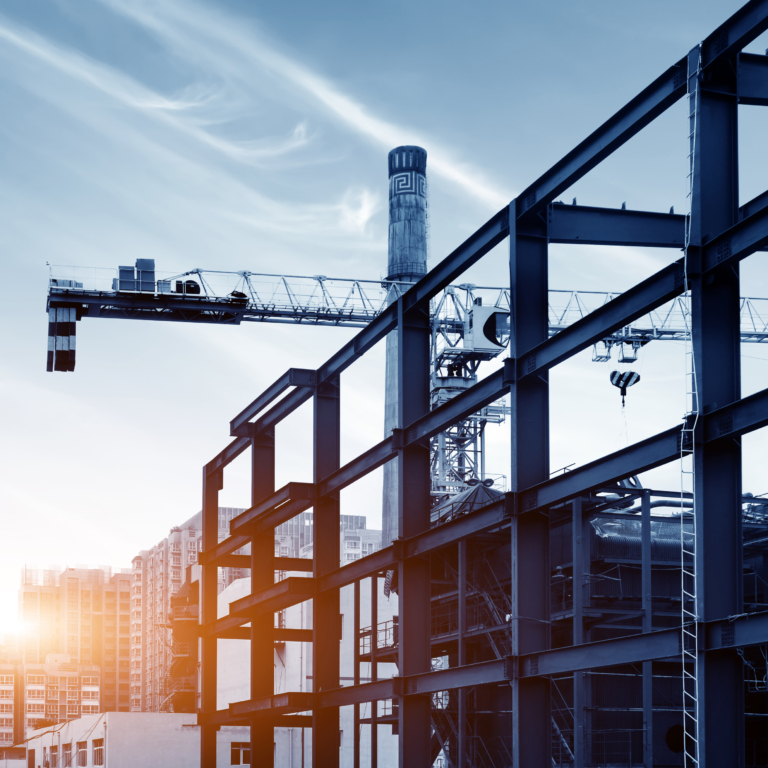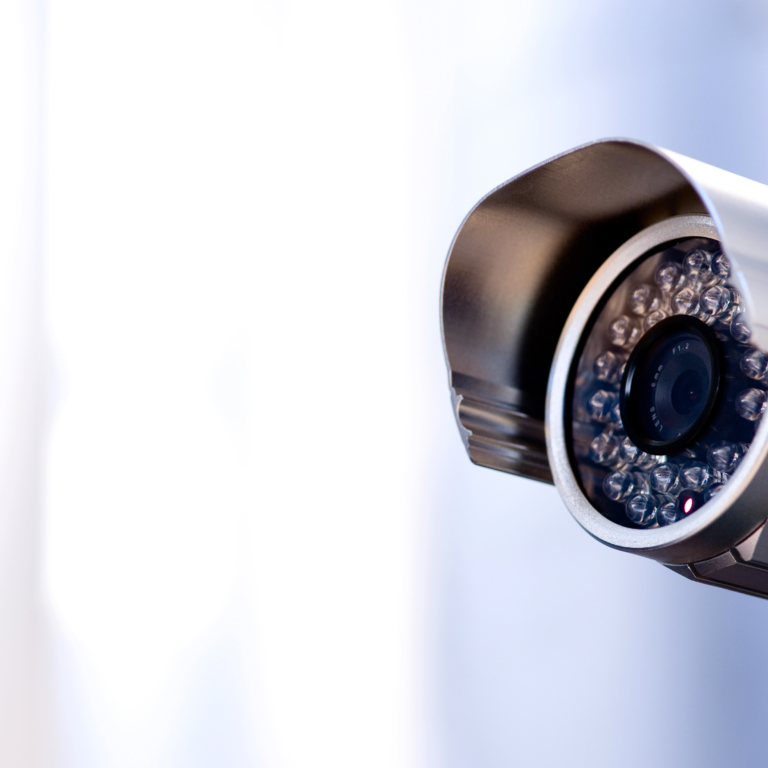5G Transformation Hub
How 5G could help transform construction
Using 5G connected robots could lead to a 30% to 40% improvement in site scanning productivity
Gammon Pte. Limited, Singtel and the Building Construction Authority of Singapore are trialling the use of 5G technologies to make building sites safer and more efficient. They are exploring multiple use cases involving robots to scan progress on the site, CCTV to bolster safety, drones for inspections and augmented reality to visualise the building process.
Select a project
Contents
Challenge
Both dynamic and temporary in nature, building sites tend to lack the ICT infrastructure to really harness digital technologies. To properly monitor large and complex construction sites requires mobile high-resolution cameras, supported by high-capacity, low latency connectivity.
Solution
Singtel has deployed a standalone 5G network and edge compute capacity to support a Gammon construction site on Sentosa Island in Singapore. 5G is used to connect robots that can scan the site in 3D,CC TV cameras (supplying footage to image recognition software),drones and headsets for augmented reality services.
Impact & Statistics
Gammon estimates using 5G connected robots, rather than human beings, to scan construction sites could lead to a 30% to 40% improvement in productivity for this process. At the same time, it believes 5G connected CC TV cameras will significantly improve safety by enabling image recognition systems to immediately detect potential hazards. It is planning to deploy both these solutions on other construction sites.
Wider Implications
5G connectivity could enable contractors to create very detailed and up-to-date digital models of a building site. These models could be used to monitor progress, verify the quality of work, manage assets and equipment, and ensure compliance with safety and environmental regulations. As a result, the construction sector could achieve a major leap forward in both safety and productivity, while boosting customer satisfaction.
Stakeholders
Singtel, the Building Construction Authority of Singapore (BCA), Gammon, Qualcomm
02
How 5G will bring construction online
Robots have transformed manufacturing. Can they do the same for construction?
Both dynamic and temporary in nature, building sites tend to lack the ICT infrastructure to really harness robotics and other digital technologies. But 5G networks could change all that. By enabling contractors to automate important on-site processes, 5G-connected robots could help achieve a major leap forward in both safety and productivity.
A trial in Singapore conducted by Gammon Pte. Limited. are demonstrating the value of 5G-enabled robotics to the building sector. The Singapore Gammon office has teamed up with mobile operator Singtel and the Building Construction Authority of Singapore (BC A) to test a range of potential applications of 5G in construction. These include using robots and drones to scan and inspect construction sites, connected CCTV cameras to check compliance with safety protocols and augmented reality to simulate planned construction processes.
The trial is taking place on Sentosa Island – Singapore’s main test bed for digital technologies – where Singtel has deployed a pioneering standalone 5G network running in the 3500 MHz spectrum band. Supported by the BC A and Govtech Singapore, the project is set to run until the end of 2022.
On Sentosa, Gammon is testing four different use cases that harness a combination of 5G connectivity and mobile edge computing. Firstly, it is using 5G connected robots provided by Boston Dynamics, running onboard software from Dconstruct Pte Ld., to track the progress of the construction site. Equipped with a Zyxel NR 2101 5G module, the robots use 3D laser scanners to collect the data required to update a detailed building information model (known as a BI M), residing in the cloud.
The 5G network is also used to connect to Geye, a wireless CCTV station, that can be moved around the site to monitor the work. It uses 5G to transmit live video back to Gammon’s command centre, where Gambot Computer Vision, a video analytics solution developed in-house by Gammon, can detect any breaches of safety protocol or potential hazards. The system can spot whether a worker is wearing a hard hat or entering a restricted area, for example. Today, the image recognition software can be used to support eight use cases, but Gammon plans to increase that number in the coming years. As the 5G-connected CCTV systems can be deployed anywhere on site, they could allow Gammon to reduce the number of supervisors it needs on each project.
In the trial, 5G is also being used to connect drones (equipped with a Quectel RM5000-GL module) that can inspect parts of the construction site that are inaccessible to a human being or robot on the ground. Employing drones in this way could speed up the inspection process, while reducing the related costs involved in provision of access for inspections such as scaffolding or cherry picker access. It also opens up the possibility for future authority inspections to be conducted remotely.
Finally, Gammon is using 5G and augmented reality to enable workers and supervisors to visualize the planned construction process on-site and detect any potential issues or challenges before the work commences. Using either a Microsoft HoloLens headset or a tablet computer, digital 3D images of each step in the planned construction process can be overlaid onto live images of the actual site. “You start seeing potential risks that you wouldn’t see if you look just at a 3D model or step-by-step pictorials,” says Michael O’Connell, general manager at Gammon.

03
Emerging safety and efficiency benefits
Gammon has already found that 5G can generate significant value. The high capacity of the 5G network allows for the detailed 3D scanning data being collected by the robots, for example, to be processed while the robot is still on the site. “This is something that we’ve never managed before,” says Michael O’Connell. “I wouldn’t say it’s the Holy Grail, but it is quite close.”
For Gammon, automating the 3D scanning process in this way generates a major productivity boost. “This is a massive benefit to us: it is a use case we definitely want to explore further,” says Michael O’Connell. “If I have got 50 to 60 scan points that I want to do in a day, I’d send two skilled employees down to the site to do that scanning and it would probably take them the entire day and even then I can’t process anything until they come back.”
Gammon typically conducts laser scanning at three stages during each project. It scans the structural works, the architectural works prior to ceilings installation and as-built status on completion of the job. Each of these stages are used to validate different stages of the project and the captured data is used to update the BIM model. Depending on the size and complexity of the project, between 60 to 120 days could be required to complete these steps.
Even though Gammon does require a human being to watch a scanning robot (to ensure it isn’t stolen), the 5G connectivity speeds up the whole process. In the past, the workers would have returned to the command centre with all the data on the memory card or on the tablet depending which scanner they were using. “Now we’re turning around the data processing quicker and we’re able to make faster decisions,” says Michael O’Connell. “The BCA is looking for between 30-40% productivity benefits and I think we are touching that.”
During the Sentosa trial, Gammon also came across a supplementary benefit. As the robots have onboard cameras, they can use 5G to transmit live images of the site back to the control centre, where image recognition software can detect any safety issues. “With that video feed, we were able to test whether a worker had his safety helmet on or was wearing the right PPE,” says Michael O’Connell. “So you’ve got robotic supervisors that can walk around laser scanning the site and also performing an autonomous monitoring role.”
Being able to employ the robots across multiple use cases further improves the business case for Gammon, enabling it to achieve a quicker return on its investment in both hardware and the broader solution. “I would imagine this would become like a fleet of robots for Gammon, where it’ll be deployed to different project sites to undertake scanning activities at different stages of the project,” Michael O’Connell says.
Gammon says the 5G-connected CC TV is also proving its worth, as it is enabling staff on site to be notified immediately about any safety or operational risks. On most large construction sites, a supervisor is “using his eyeballs to monitor and to track his workers on safety compliance,” notes James Chan Yung Hau, Assistant Director, 5G Ecosystem & Partnerships, Singtel. “But a supervisor can only watch one place at a time. With connected high-resolution cameras, I can run all these different AI algorithms on the same video feed on the edge compute to check for safety equipment, clustering, social distancing, and other potential hazards. The supervisor can be alerted through their mobile computing device, if there are breaches.”
For larger construction projects involving scores of workers, this kind of monitoring could greatly improve safety and ultimately efficiency. Although he can’t yet quantify the benefit, Michael O’Connell expects this system to result in a significant reduction in accidents. As coverage expands, Gammon is likely to deploy 5G connected CC TV on every project it undertakes.
Gammon is also enthusiastic about using augmented reality to visualise the sequence of construction on a digital twin of the site. “The trial that we did on Sentosa was very, very successful,” says Michael O’Connell. “You’re essentially taking an operations team or your safety team and you’re going through the step-by-step installation in the actual location on site, a digital trial run for the upcoming activity. So we will certainly be looking at using that for some of the key risk activities on our new MRT (the mass rapid transit system in Singapore) project.”
Although 5G-connected drones will also make it easier to inspect and monitor construction sites, Michael O’Connell believes this use case will require a longer gestation period. He says it will take time to convince clients that “they can actually conduct these inspections remotely and still maintain control over the inspection. I don’t think we will be able to roll this out for many projects over the next year or two.” In the longer term, the widespread use of drones for inspecting construction is likely to depend on whether they can meet requirements set out by the building control authorities.


James Chan
Assistant Director, 5G Ecosystem & Partnerships, Singtel
04
5G provides sufficient capacity and latency
The Sentosa trial follows on from tests Gammon originally conducted with LTE and Wi-Fi, which both lacked the bandwidth and the responsiveness required for some of the use cases. In the absence of 5G, the network latency wasn’t low enough to remotely control robots or drones, for example.
“Gammon experimented,” explains James Chan. “But they faced difficulties in terms of latency in transmitting all the video feed back to the command centre. If they don’t have that video feed in real time, the inspectors may have to redo it again. That translates into a loss of productivity. The key thing is the low latency of 5G.”
At the same time, the additional capacity provided by 5G means multiple video analytic use cases can be run off a single CC TV camera. It also allows for the transfer of large cloud point data files generated from the 3D laser scanning. “You need 5G capabilities because of the size of the data you’re dealing with now with some of the BIM models, they’re so detailed,” explains Michael O’Connell. “If you want to use those models for verification of what you’ve built, then you need that 5G capability. If I want to laser scan something and overlay it for the BIM model, I can get a very accurate representation. But if you don’t have the bandwidth or you don’t have the latency, the 3D model tends to drift.”
The initial findings from the Sentosa trial suggest to Gammon it will certainly earn a return on an investment in 5G connectivity on construction sites where the work is above ground. Now it needs to run trials in subterranean environments.
“We’re already thinking of using one or two of these use cases on other projects,” says Michael O’Connell. “We have just started a new project for the MRT (the mass rapid transit system in Singapore). As it is a below ground project, it has a few more challenges in terms of whether there’s sufficient 5G network signal to drive the technology. But that’s one of the reasons why we’d like to test it: we do a wide range of projects, some above ground, some below ground. All of them have their own sort of IT infrastructure challenges to them.”


James Chan
Assistant Director, 5G Ecosystem & Partnerships, Singtel
05
Bringing together the pieces of the puzzle
As well as creating the necessary image recognition software, Gammon has developed its own dashboard to aggregate and display the data about its construction sites. Singtel is providing both the 5G connectivity and edge computing infrastructure to support the low latency required for real-time image recognition.
Gammon is using a campus 5G network (rather than a private network) running in the same spectrum as a public 5G network. Singtel charges a monthly subscription for connectivity, with the price dependent on the amount of data traffic customers need. The operator charges for edge computing capacity on a similar basis.
Although 3GPP has yet to complete the necessary standards to support dynamic network slicing, Singtel is able to provide customers with a pre-defined slice of 5G connectivity designed specifically to meet their throughput and latency requirements.
For Singtel, deploying similar solutions on other construction sites may depend on whether the locations already have adequate 5G coverage. The provision of temporary 5G coverage can be difficult, primarily because of the need for a backhaul link between the new base station and the rest of the network. “In a construction site, if we don’t have the fibre already or we don’t have a point connection to the fibre, it will be a challenge,” says James Chan. “We don’t like laying cables and things like that. In construction, with different stages of progress, the landscape of the site changes: We cannot just lay a cable across the road because that road may move.” One potential solution will be to develop portable base stations that use point-to-point wireless solutions for backhaul.

06
Potential to expand into more use cases
Once a construction site has 5G connectivity, portable robotic scanners and image analytics, these technologies could be used for a wide range of purposes. They could, for example, be used for asset and inventory management – to verify the location and condition of equipment and materials. The system could automatically check whether the site has enough bricks, tiles or RSJ beams, for example.
“Potentially, there are more use cases for 5G on construction sites,” notes Michael O’Connell. “Whatever technology you’re looking at or whatever idea you’re having the biggest constraint was always the network.”
The usage of 5G in construction is likely to be driven by both the potential productivity and safety gains, and building regulations. Regulators may well require large construction sites, for example, to demonstrate digitally that they are meeting specific safety and environmental standards.
As 5G coverage expands and improves, every part of a construction site could be monitored by high definition cameras that could use 5G to deliver a continuous video stream to the command centre. With image recognition software, it would then be feasible to build a very detailed real-time model of the site, which could then be used to verify the quality of the work and compliance with both safety and environmental regulations, for example. The net result would be a highly-detailed digital record of the work, which could then be used to help fix any faults or resolve any disputes.

07
About
About the GSMA
The GSMA is a global organisation unifying the mobile ecosystem to discover, develop and deliver innovation foundational to positive business environments and societal change. Our vision is to unlock the full power of connectivity so that people,
industry, and society thrive. Representing mobile operators and organisations across the mobile ecosystem and adjacent industries, the GSMA delivers for its members across three broad pillars: Connectivity for Good, Industry Services and Solutions, and Outreach. This activity includes advancing policy, tackling today’s biggest societal challenges, underpinning the technology and interoperability that make mobile work, and providing the world’s largest platform to convene the mobile ecosystem at the MWC and M360 series of events.
For more information, please visit the GSMA corporate website at www.gsma.com.
Follow the GSMA on Twitter: @GSMA.
GSMA 5G Transformation Hub
The GSMA 5G Transformation Hub is a source of information on some of the most innovative 5G solutions in the world. This portal contains case studies detailing design, benefits, key players, measured value and the future impact of scaling up these 5G solutions worldwide. The 5G Era is now firmly established and this family of standardised GSM technologies, including mmWave, are being rolled out successfully across the globe. The GSMA 5G Transformation Hub, launched at MWC Barcelona in 2022, provides details of how 5G is best placed to deliver real value for a range of key sectors including manufacturing, energy, transportation, media and live entertainment, smart cities and construction.. Many more case studies will be added, in the coming months, covering even more industries and the GSMA is asking Members to nominate innovative 5G case studies to add to this global digital showcase. The 5G Transformation Hub and this particular Case Study are both sponsored by Qualcomm.
About this case study
This case study is for information only and is provided as is. The GSM Association makes no representations and gives no warranties or undertakings (express or implied) with respect to the study and does not accept any responsibility for , and hereby disclaims any liability for the accuracy or completeness or timeliness of the information contained in this document. Any use of the study is at the users own risk and the user assumes liability for any third party claims associated with such use.